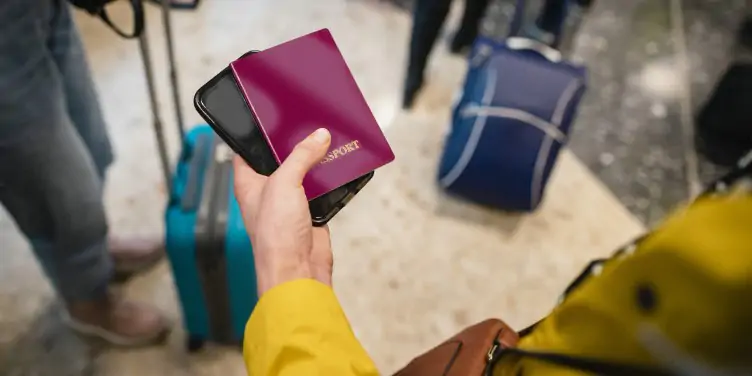At a glance:
- The EU Entry/Exit System (EES) rollout starts 12 October 2025
- Applies to non-EU (including UK) visitors to the Schengen Area
- First trips will require fingerprints and facial scans – refusal means no entry
- Travellers may be asked for a return ticket, accommodation details, proof of funds and proof of medical cover; these aren’t mandatory, but not having them to hand could mean further questioning
You’ve probably seen the headlines about new EU travel rules coming in autumn 2025. With so much talk about what might change, it’s no wonder many UK travellers are left wondering what to expect at the airport. Here’s a look at what we know so far, and what it could mean for your next holiday.
What is EES?
From 12 October 2025, a new EU border system called the Entry/Exit Scheme (EES) is due to roll out, replacing passport stamps with a digital record of when and where you cross the border. It’s being phased in across airports, ports and stations, and is expected to be fully in place by April 2026.
The EES rules will apply to most non-EU travellers visiting the Schengen Area – that’s 29 countries where you can usually move freely once you’re inside. For UK holidaymakers, it covers favourites like Spain, Italy, France and Greece, as well as destinations such as Switzerland, Norway and Iceland. In other words, the places many of us travel to most often.
What about ETIAS?
You might have also heard about something called the European Travel Information and Authorisation System (ETIAS). It often gets mentioned alongside EES, but it’s a separate scheme.
ETIAS is expected to launch once EES is fully in place. When it does, UK travellers will need to apply for travel authorisation before heading to Schengen countries, a bit like the ESTA system for the USA.
What will happen at the border under EES?
On your first trip after the EES launches, you’ll need to provide fingerprints and a facial scan along with your passport. This part is mandatory – if you refuse, you won’t be allowed in.
You might also be asked for extra details. This isn’t new – under the Schengen Borders Code, guards have always been able to request additional information. What the EES is likely to change is how routinely these checks are carried out. You might be asked for:
- the purpose of your trip (e.g. business or leisure)
- details of your return ticket, to show you’re travelling home
- confirmation of where you’ll be staying (e.g. a printout of your booking or letter or invitation if you’re staying with a friend or family)
- evidence of funds for your trip
- proof of medical cover
These aren’t legal requirements in the way the biometric checks will be. But if you can’t provide the details when asked, you may be sent for further checks. This doesn’t necessarily mean you’ll be turned away, but could mean longer wait times, especially whilst the system is bedding in.
Will I need travel insurance for Europe?
One of the biggest questions around the EES rules is what border officials will accept as proof of medical cover. Some reports suggest that a Global Health Insurance Card (GHIC) might be enough, while others have raised the possibility that officials could expect a travel insurance validation certificate. While guidance is still unclear, the important thing to know is that the two aren’t interchangable.
GHICs (or the older EHICs) let you use state healthcare in EU countries, usually at the same cost as a local. They can help with:
- emergency medical care for accidents or sudden illness
- treatment deemed medically necessary for long-term or pre-existing conditions
- routine maternity care (unless you’re travelling abroad to give birth)
- kidney dialysis and oxygen
But there are limits. GHICs won’t cover private treatment, getting you home if you’re seriously unwell, or any non–medical costs.
Travel insurance can step in for some of those costs, including:
- medical repatriation (bringing you home in an emergency)
- extra costs when state care isn’t fully free – such as scans, medical equipment, or hospital stay charges
- additional expenses if your trip is disrupted, such as accommodation or new travel arrangements
- protection for cancellations, delays, and lost or stolen baggage
It also gives you something straightforward to show if you’re asked at the border, so you’re not left second-guessing whether a GHIC will be accepted. Without it, you could face large bills or risk being stuck abroad longer than planned.
What about worldwide travel insurance and non-Schengen countries?
The EES only applies when you’re entering the Schengen Area. But if you’re heading elsewhere, there may be different rules to note. Some worldwide destinations, like Turkey, don’t accept GHICs, and require proof of travel insurance.
It’s always worth checking the UK Government’s foreign travel advice for the latest information.
Getting ready for the EES
As the EES is introduced, some of the finer details could change, which is why it helps to keep up to date before you travel. What won’t change is the value of being prepared – prepared for longer wait times, prepared with the right documents at the border, and prepared with a travel insurance policy able to step in if things don’t go to plan.
Avanti policies include cover for pre-existing medical conditions, have no upper age limit, and provide 24/7 medical support while you’re abroad. They also give you straightforward proof of medical cover if you’re asked at the border – that’s travel reassurance.



